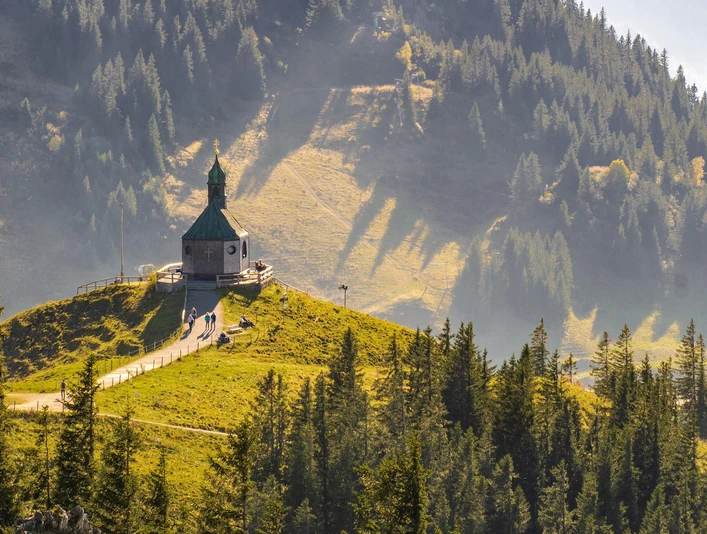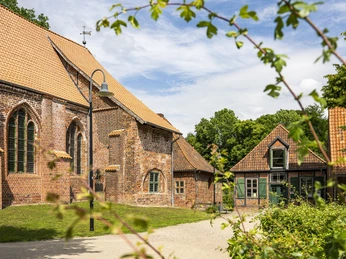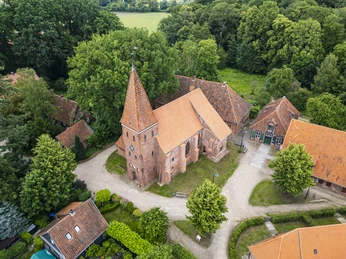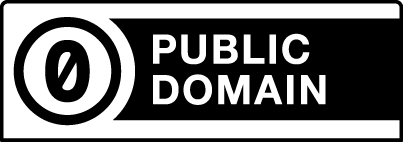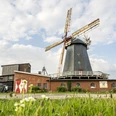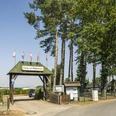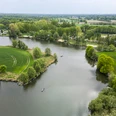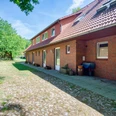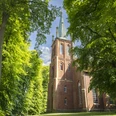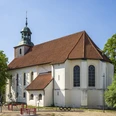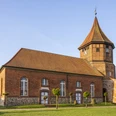- Photos & Map
How would you like to arrive?
- Call
- Description
- Good to know
- Nearby
In 1251, the first mention of the "House of the Poor Sick", which was located just outside the gates of Bardowick on the road to Lüneburg, appears in an old document. In this document, the Bishop of Verden confirms that the hospital is entitled to the "tithe" from the estates of Dominus Wido. Originally, this facility belonged to the town of Lüneburg and served as accommodation for lepers.
The name St. Nikolaihof is mentioned for the first time in 1316. After leprosy had disappeared in the 14th century, the Nikolaihof was converted into a home for the elderly, which the citizens of Lüneburg could buy into. Men and women, including married couples, lived in separate buildings. A detailed account book from the years 1410-1466, kept by the Lüneburg counsellor Hinrik Lange, who ran the old people's home, shows that forty men and women lived in the buildings. In addition, forty people worked here, including farmhands, maidservants, shepherds, sexton, organist, pastor and court master. The income came from various sources such as Lüneburg salt pans, land, the bathing parlour, fish banks, alms stalls and much more.
The economic situation was so stable that the administrator Hinrik Lange had extensive renovations carried out. The farmyard was paved, a new fence was erected and the washing jetties on the Ilmenau were fortified. Even a river water pipe was laid for the modern "pishuse", the privy. In 1435, Councillor Lange had the brick chapel rebuilt, whereby the outer walls were raised and the windows enlarged. The tower was added in the early 15th century and in May 1436, the Bishop of Verden consecrated the rebuilt chapel with three altars.
The Old Men's House dates back to the early 14th century, as recent dendrochronological studies have shown. The imposing roof truss was built in 1316 and the room structure of the house with individual chambers along the long corridor has been preserved to this day. Other buildings such as the 15th century rectory, the organist's house and the provisional house from the 16th and 17th centuries as well as the new men's house from the 17th century and the women's house newly built in 1720/21 characterise the site. Above the main entrance to the women's house, the head of Medusa, carved from sandstone, is said to ward off all evil.
The name St. Nikolaihof is mentioned for the first time in 1316. After leprosy had disappeared in the 14th century, the Nikolaihof was converted into a home for the elderly, which the citizens of Lüneburg could buy into. Men and women, including married couples, lived in separate buildings. A detailed account book from the years 1410-1466, kept by the Lüneburg counsellor Hinrik Lange, who ran the old people's home, shows that forty men and women lived in the buildings. In addition, forty people worked here, including farmhands, maidservants, shepherds, sexton, organist, pastor and court master. The income came from various sources such as Lüneburg salt pans, land, the bathing parlour, fish banks, alms stalls and much more.
The economic situation was so stable that the administrator Hinrik Lange had extensive renovations carried out. The farmyard was paved, a new fence was erected and the washing jetties on the Ilmenau were fortified. Even a river water pipe was laid for the modern "pishuse", the privy. In 1435, Councillor Lange had the brick chapel rebuilt, whereby the outer walls were raised and the windows enlarged. The tower was added in the early 15th century and in May 1436, the Bishop of Verden consecrated the rebuilt chapel with three altars.
The Old Men's House dates back to the early 14th century, as recent dendrochronological studies have shown. The imposing roof truss was built in 1316 and the room structure of the house with individual chambers along the long corridor has been preserved to this day. Other buildings such as the 15th century rectory, the organist's house and the provisional house from the 16th and 17th centuries as well as the new men's house from the 17th century and the women's house newly built in 1720/21 characterise the site. Above the main entrance to the women's house, the head of Medusa, carved from sandstone, is said to ward off all evil.
Good to know
Eligibility
for Groups
for Class
for individual guests
Suitable for the Elderly
for Children of all Ages
Directions & Parking facilities
Accessible from Lüneburg with bus 5002 to the Nikolaihof stop.
You can also combine the Nikolaihof with a historical stroll through the town of Bardowick.
You can also combine the Nikolaihof with a historical stroll through the town of Bardowick.
Contact person
Author
Organization
Flusslandschaft Elbe GmbH
License (master data)
Flusslandschaft Elbe GmbH
Our recommendations
Nearby
